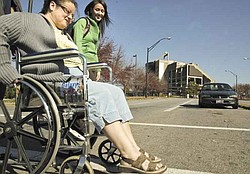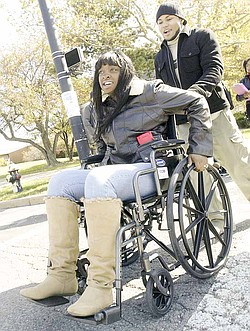Course experience
Brenda Wagner, a student at Youngstown State University, makes her way across Fifth Avenue with YSU physical-therapy major Kristie LaCivita. Wagner rolled across the busy road Wednesday morning as a participant in Where There’s a Wheel There’s a Way, an initiative by YSU’s Physical Therapy Department. October is Physical Therapy Month.
Ariel Holmes, a Youngstown State University student from Warren, wheels across Fifth Avenue with the help of Robert Martin, a physical-therapy student at the university. The pair participated Wednesday in the Where There’s a Wheel There’s a Way program.
Where There’s a Wheel There’s a Way
By Denise Dick
YOUNGSTOWN
Kari Tridle never thought about the difficulty of crossing Fifth Avenue in a wheelchair until she did it.
The Youngstown State University senior from Idaho rolled across the busy road Wednesday morning as a participant in Where There’s a Wheel There’s a Way, an initiative by YSU’s Physical Therapy Department. October is Physical Therapy Month.
“I hurt my shoulder, so I couldn’t go across by myself,” Tridle said.
One of the physical-therapy students helped her, pushing the chair.
“It would have been really difficult — especially if I’d had to do it myself — to get across in time,” she said.
The length of time to cross at an intersection, the height of curbs and the difficulty of navigating campus in a wheelchair weren’t things Tridle thought about before she tried it.
Crossing Fifth by Taco Bell was one of eight places where students, faculty and staff members could experience using a wheelchair on campus. Some of the others were at Lincoln and Wick avenues, the fountain to the east of Kilcawley Center and the wheelchair ramp to the fourth floor of Ward Beecher Hall.
Marleen Iannucci, a professor in the department, said this marks the ninth year for the wheelchair program.
“There are two things that we hear,” she said of participants. “One is that it’s more difficult to get around in a wheelchair than they thought, and the second is if they had to be in one all day. ...”
Physical-therapy students also surveyed participants, asking whether they’re aware of the Americans with Disabilities Act, if they know about People First Language and their awareness of the availability of disability services on campus.
Iannucci is surprised about how many people don’t know about the ADA, the law prohibiting discrimination against people with disabilities. It also ensures accessibility to buildings, facilities and transit vehicles.
People First is the idea that in referring to a person with a disability, he or she should be called a “person with blindness” rather than a “blind person.”
“Person before disability,” Iannucci said.
One of her pet peeves is when media reports call someone “wheelchair bound” or “confined to a wheelchair.”
“You’re not bound to a wheelchair,” Iannucci said. “Wheelchair users. A person uses wheelchairs like you use a car.”
Brenda Wagner, a junior from Struthers, said it was difficult to wheel herself across the street.
What if she had to navigate in a wheelchair all the time?
“I suppose I’d get used to it, but it’s not something I want to do,” Wagner said.
Canfield freshman Tom Hubert had trouble steering the wheelchair across the street. It was more difficult than he expected.
 43
43


